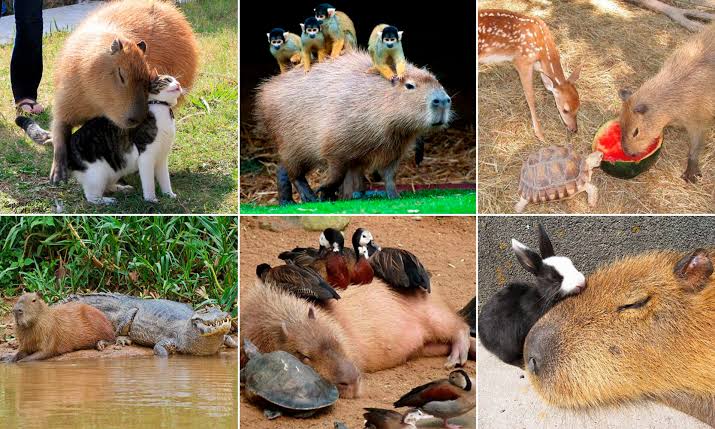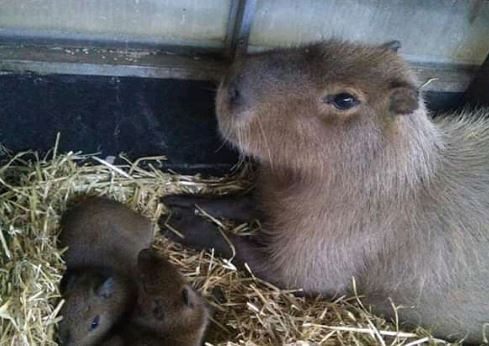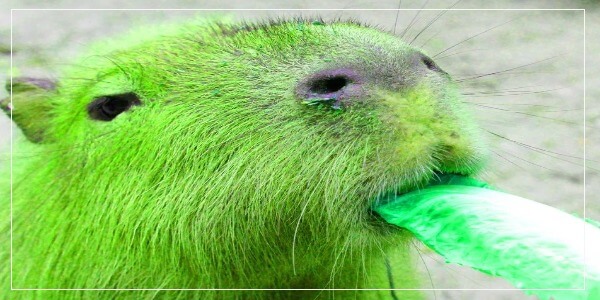The capybara is a semi-aquatic mammal native to South America. These fascinating creatures adapt well to their environment. They possess a stocky body, webbed feet, and specialized teeth, allowing them to thrive in terrestrial and aquatic habitats. One of its primary habitats is the Amazon rainforest.
The Amazon rainforest is renowned for its wide biodiversity and immense ecological importance. With its complex and dynamic ecosystem that presents numerous challenges and opportunities for its inhabitants, many wonder how capybaras survive in this environment.
How Do Capybaras Survive in the Amazon Rainforest?
Capybaras have evolved a range of adaptations to survive in the Amazon rainforest. These remarkable creatures have developed strategies to navigate their habitat, regulate their body temperature, and secure their food supply. Below is a breakdown of how these beautiful rodents survive in the rainforest.
1. Physical Adaptations for the Rainforest
Capybaras have several physical adaptations that aid their survival in the rainforest. Their stocky bodies, powerful limbs, and webbed feet make them excellent swimmers. As a result, they can move through rivers, lakes, and flooded areas.
The webbing between their toes helps propulsion through water and facilitates efficient movement on muddy terrain. Their eyes and nostrils are positioned on top of their heads. This allows them to watch for predators while partially submerged in the water. This adaptation is particularly advantageous for capybaras as they rely on terrestrial and aquatic habitats for foraging and escaping danger.
2. Thermal Regulation Mechanisms
Capybaras living in the rainforest often face the challenges of temperature and humidity. Capybaras adopt thermoregulatory mechanisms, such as wallowing in water or mud, to regulate their body temperature. These activities cool their bodies and relieve the heat.
Additionally, capybaras possess sweat glands on their noses, which help dissipate heat. Seeking shade under vegetation or taking refuge in water bodies also helps them avoid direct exposure to the scorching sun.
3. Diet and Feeding Habits
Capybaras are herbivores with a diet primarily consisting of grass and other vegetation. In the Amazon rainforest, they feed on various plant species, including aquatic plants, fruits, and tender shoots. Their large incisor teeth and efficient chewing mechanisms allow them to graze on tough vegetation.
Also, Capybaras are selective feeders, consuming diverse plants to meet their nutritional requirements. This flexibility in their diet helps them adapt to seasonal food sources available in the rainforest.
4. Social Behavior and Herd Dynamics
They are highly social animals, forming large herds that provide protection, enhance foraging efficiency, and promote strong bonds. A dominant male typically leads these herds, while multiple females and their offspring comprise the rest of the group.
Living in large numbers helps capybaras deter potential predators through collective vigilance. The social structure also facilitates cooperative care of young capybaras, ensuring their survival in the challenging rainforest environment.
5. Habitat and Shelter
Capybaras find habitat in the Amazon rainforest’s diverse wetland environments, including riverbanks, marshes, and lakeshores. They seek areas with dense vegetation and water sources for foraging and shelter.
During the daytime, capybaras often rest in vegetation near water bodies, finding refuge from predators and intense sunlight. They can also dig burrows or use existing holes as shelter, providing protection from extreme weather conditions and potential threats.
6. Dealing with Natural Predators
Capybaras are large, but they still face predation in the rainforest. Their survival strategies include remaining vigilant and relying on their keen senses to detect predators. When threatened, capybaras can swiftly take refuge in water bodies, utilizing their swimming abilities to evade predators such as jaguars, anacondas, and caimans.
The advantage of living in large herds also helps with predator detection and deterrence, as the combined vigilance of multiple individuals increases the likelihood of spotting potential threats.
Are Capybaras Endangered in the Amazon Rainforest?
Capybaras are not currently endangered in the Amazon rainforest. They are listed as a species of “Least Concern” on the International Union for Conservation of Nature (IUCN) Red List. However, monitoring their population and threats is imperative to ensure their long-term survival.
One of the major threats capybaras face is habitat loss. Deforestation for agriculture, logging, and infrastructure development can result in the loss of their natural habitats. This loss reduces the availability of suitable feeding grounds, water sources, and shelter, impacting capybara populations.
Another major threat is hunting and poaching. In certain regions, capybaras are targeted for meat, skin, and other body parts. Subsistence hunters target them for commercial wildlife products trade. Although hunting pressure may not be a significant threat on a global scale, it can impact local populations, especially when combined with other factors.
While capybaras face these threats, you must know that conservation efforts are going on to ensure their continued existence. Here are some of the efforts below.
- Establishing Protected Areas: Protecting and managing protected rainforest areas safeguards capybara populations and habitats. These areas provide legal protection, regulate activities, and promote conservation measures.
- Habitat Restoration: Restoration initiatives focus on reforesting and rehabilitating degraded areas to restore capybara habitats. Restoring natural vegetation provides food sources, shelter, and connectivity for capybaras and other wildlife.
- Implementing Wildlife Management: Sustainable wildlife management practices and regulations help ensure hunting is conducted responsibly, considering capybara population dynamics and maintaining healthy populations.
- Community Engagement: Involving local communities in conservation efforts is crucial. Education and awareness programs promote capybara ecology and sustainable practices for conservation.
Do Capybaras Live Alone or in Groups in the Amazon Rainforest?
Capybaras are highly social animals and prefer large groups in the Amazon rainforest. They form a complex social structure within their herds with strong bonds among their group members.
Within the herds is a social hierarchy known as the dominance hierarchy. This hierarchy is established through various behavioral displays, such as posturing, vocalizations, and physical interactions. Dominant individuals hold higher status and have priority access to resources like food and mating opportunities. Subordinate members respect higher-ranked individuals’ dominance.
While there is a hierarchy, aggression is limited within the group. They often engage in social grooming, which boosts group cohesion. You should also note that capybaras are not territorial animals, as they share their habitat with other herds. There are many advantages these creatures enjoy by living in herds. Here are some advantages below.
Predator Detection: Living in a large group enhances capybaras’ ability to detect potential predators. With multiple individuals scanning their surroundings, there is a higher chance of detecting approaching threats. Capybaras have keen senses and can alert the herd through vocalizations or alarm calls, enabling a coordinated response.
Dilution Effect: Numerous individuals in a herd reduce the risk for each capybara. Predators tend to target a single, isolated individual rather than prey on a large group.
Cooperative Defense: When a predator is spotted, capybaras cooperate. They can mob and intimidate predators, showing aggression and using their size and teeth as deterrents. By working together, they discourage or distract predators from approaching the herd.
Thermoregulation: Capybaras engage in “huddling” to maintain body temperature during cooler periods. When huddled, individuals gather closely together, generating and conserving heat simultaneously. This behavior is more effective in larger herds, where combined body heat helps with thermal regulation.
Conclusion
Capybaras demonstrate remarkable survival strategies in the Amazon rainforest, highlighting their adaptability and resilience as unique creatures. Their physical adaptations, such as webbed feet, specialized teeth, and eyes positioned high on their heads, enable them to maneuver through water bodies. They feed on a diverse diet and have a clear line of sight for detecting potential threats.
We have discussed everything you should know about this creature and its adaptability in the rainforest. Read through this article to get all the details you need.


![Why Do Capybaras Not Have Tails? - [Answered] Why Do Capybaras Not Have Tails](https://capybaratips.com/wp-content/uploads/2023/03/Capy-Tail-250x200.webp)
![Capybara Meat And Its Culinary Uses - [Every You Should Know] Capybara Meat & Culinary Uses](https://capybaratips.com/wp-content/uploads/2023/03/Capybara-meat-250x200.webp)

![How Long Do Capybaras Live? - [Answered] How Long Do Capybaras Live](https://capybaratips.com/wp-content/uploads/2023/03/Capybara-Pix-250x200.webp)
![How Big Should a Capybara Enclosure Be? - [Sizes & Design] How Big Should a Capybara Enclosure Be](https://capybaratips.com/wp-content/uploads/2023/03/Capy-Enclosure-250x200.webp)


